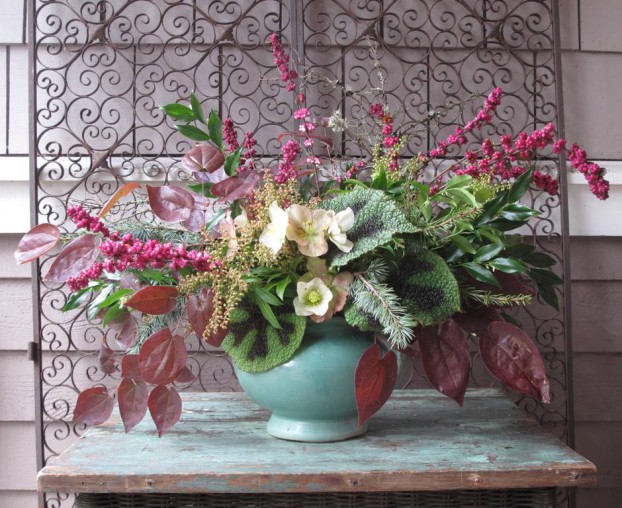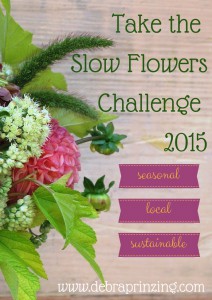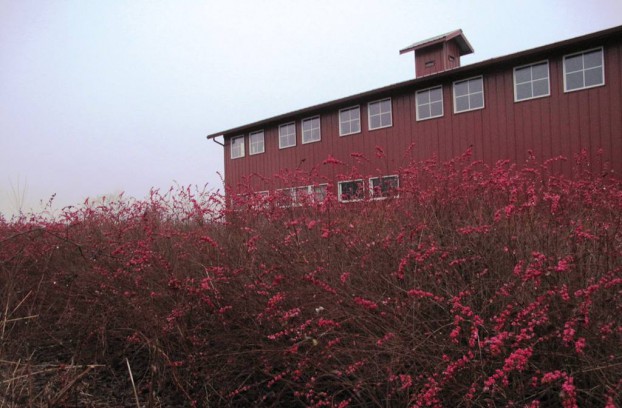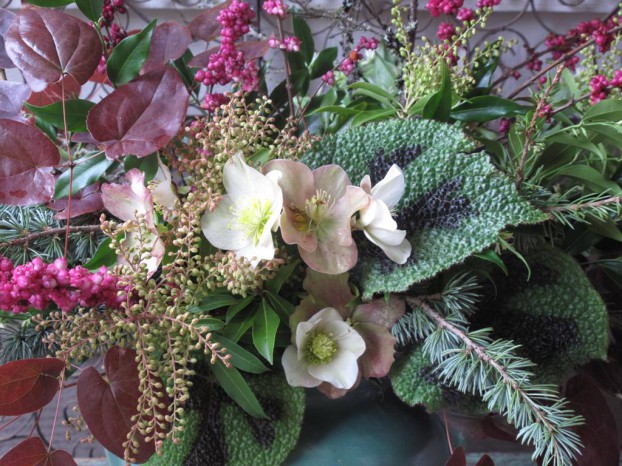January 16th, 2015

January 15, 2015 Slow Flowers Challenge arrangement
 I hope you are having a wonderful beginning to your New Year of Local Flowers!
I hope you are having a wonderful beginning to your New Year of Local Flowers!
This season and the subsequent ones throughout the year will provide us with beautiful,
American Grown botanicals. As we train our eyes, plan our gardens and seek local sources for our flowers, I hope that the
Slow Flowers Challenge will inspire and inform you!
Week 1: We launched the Slow Flowers Challenge on
January 5th and to date,
more than 250 people have downloaded the
Resource Design Guide to get their own Slow Flowers Project started. Please feel free to share this project with your friends. I encourage people to begin whenever the timing is right – and continue regularly by week, month or season.
For my own arrangement, for Week 2 of 2015, I was inspired by these vivid magenta-purple snowberries,which I saw growing en masse at Jello Mold Farm in Mt. Vernon.
This is the farm portrayed on the cover of The 50 Mile Bouquet, one of the most productive and sustainable small cut flower farms I’ve ever visited.

A huge stand of snowberry shrubs look gorgeous against the red barn at Jello Mold Farm
Owners Diane Szukovathy and Dennis Westphall encouraged me to cut as many of the stems as I wished. It was already dusk and there was something quite wistful about harvesting floral elements in the waning winter light of January 10th.
I was excited to create an arrangement worthy of all that brilliant fuchsia. I filled a glass pitcher with the snowberry stems when I came home, and then . . . of course, GOT TOO BUSY to design.
Tuesday, while walking my elderly dog Zanny on what was actually a slow craw down the sidewalk of my neighborhood, I spotted my next design ingredient! Branches of blue atlas cedar covered the ground, knocked from a majestic tree during a recent storm. They looked like a graceful gesture depicted in a black-and-white sumi painting. I gathered a few and carried them home.
The teal-blue tinge of the needles seemed the perfect complement to the snowberries. Later that day, I eyed a piece of vintage turquoise pottery, something I ordered from eBay.com a few years ago, mainly because the glaze was so beautiful – darker than most of my other vintage vases.

Lots of texture, color, detail and seasonal interest!
That’s when the entire design came together in my mind’s eye. I just had to walk the rather dormant winter garden with clippers in hand to find the remaining elements to complete my design. Here’s what I clipped yesterday before getting started:
- Sweet box (Sarcococca ruscifolia), with glossy green foliage and tiny white fringes of super-fragrant, vanilla-scented flowers.
- Japanese andromeda (Pieris japonica), a fantastic shrub with chains of flowers emerging from the tips. I cut mine pre-bloom, so the strings of tiny buds are a pale pinkish-gold color.
- Bishop’s hat (Epimedium sp.), a rather generic evergreen groundcover (the previous owner of our home planted way too many of them!) with wiry stems and a pointed leaves – thus, the “bishop’s hat.” Some of the varieties turn dark red-brown when temperatures drop, like the ones that I used in my bouquet.
- Cedar branches, that echo the pottery glaze beautifully. A few of the curved stems drape downward from the rim of the container, which I love.
- Lichen-covered bare branches from a weathered azalea. You can’t see them well in the photo, however, let me assure you that the pale green lichen also echoes the vase’s glaze.
- Lots of snowberries, which arch quite nicely above most of the foliage, just where I wanted them in the vase.
- Three stems of ‘Joseph’ Hellebores, clipped from a container in front of my home. Blooms are rare so I used these for impact.
- Finally, I knew I wanted something bold, so I added three stems from a Rex Begonia houseplant. I believe this variety is called ‘Iron Cross’ and you can see why.
TIP: American Grown Flowers
Winter can be a challenge to find more conventional blooms, especially if you live in Zones 3-6, right? I was inspired by an event held last week at the Seattle Wholesale Growers Market (full disclosure – I’m on the board of this farmer-to-florist cooperative).
We hosted
Christina Stembel of SF-based
Farmgirl Flowers, and you can see her design here. Christina discussed the huge variety and availability of
California-grown flowers that she relies on, year-round. She encouraged Seattle area designers to draw a larger circle in their definition of “local” during the times when most local flower farms are dormant or experiencing lower productivity.
Look for CA-Grown labeling when you’re shopping at the supermarket. You’ll find beautiful flowers that are grown by U.S. farmers – all part of keeping it SLOW!
Christina’s design features California-grown eucalyptus, privet berries, garden roses, tulips, fancy-leaf pelargonium, ornamental cabbage & scabiosa.
Share Your SLOW FLOWERS Bouquets
About Our Pinterest Boards
When I launched the SLOW FLOWERS CHALLENGE for 2015, I asked people to create their own designs using American grown, local and seasonal botanicals, and then to “share” their designs on our Pinterest board, which I had planned to set up for each month of the year.
Here is the January Board.
Easy, right?
Not so easy. I did not realize that I have to INVITE YOU to join this board. I hope you create your own boards, which is something I’ve seen lots of you do. Please invite me to post to your Slow Flowers Challenge Pinterest Board and I will reciprocate and invite you to join ours, which I have made a “Group Board.” Let’s use the #slowflowerschallenge hash-tag when possible, so we can find and enjoy each other’s beautiful and seasonal work!
This entry was posted
on Friday, January 16th, 2015 at 5:42 pm and is filed under American Grown, Blog Posts, Creativity, floral design, Flower Farming, General, Plants, Slow Flowers Challenge.
You can follow any responses to this entry through the RSS 2.0 feed.
You can leave a response, or trackback from your own site.















January 21st, 2015 at 1:40 pm
Love this idea so I have started a board with my first bouquet up. I used flowers and greenery from my garden this week.